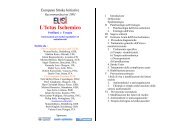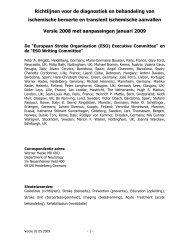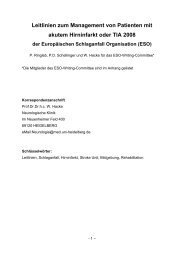Guidelines for Management of Ischaemic Stroke 2008 - ESO
Guidelines for Management of Ischaemic Stroke 2008 - ESO
Guidelines for Management of Ischaemic Stroke 2008 - ESO
You also want an ePaper? Increase the reach of your titles
YUMPU automatically turns print PDFs into web optimized ePapers that Google loves.
<strong>ESO</strong>-<strong>Guidelines</strong> <strong>for</strong> <strong>Management</strong> <strong>of</strong> <strong>Ischaemic</strong> <strong>Stroke</strong> <strong>2008</strong><br />
While only a minority <strong>of</strong> stroke patients present in an immediately life-threatening<br />
condition, many have significant physiological abnormalities or comorbidities.<br />
Symptoms and signs which may predict later complications such as space-occupying<br />
infarction, bleeding, or recurrent stroke, and medical conditions such as hypertensive<br />
crisis, co-existing myocardial infarction, aspiration pneumonia, or cardiac and renal<br />
failure, must be recognized early. <strong>Stroke</strong> severity should be assessed by trained staff<br />
using the National Institutes <strong>of</strong> Health <strong>Stroke</strong> Scale (NIHSS) [103].<br />
Initial examination should include:<br />
• observation <strong>of</strong> breathing and pulmonary function<br />
• early signs <strong>of</strong> dysphagia, preferably with a validated assessment <strong>for</strong>m [104]<br />
• evaluation <strong>of</strong> concomitant heart disease<br />
• assessment <strong>of</strong> blood pressure (BP) and heart rate<br />
• determination <strong>of</strong> arterial oxygen saturation using infrared pulse oximetry if<br />
available.<br />
Simultaneously, blood samples <strong>for</strong> clinical chemistry, glucose, coagulation and<br />
haematology studies should be drawn, and a venous line inserted. The examination<br />
should be supplemented by a medical history that includes risk factors <strong>for</strong> stroke and<br />
cardiac disease, medications, conditions that may predispose to bleeding<br />
complications, and markers <strong>for</strong> stroke mimics. A history <strong>of</strong> drug abuse, oral<br />
contraceptive use, infection, trauma or migraine may give important clues,<br />
particularly in young patients.<br />
- 16 -





